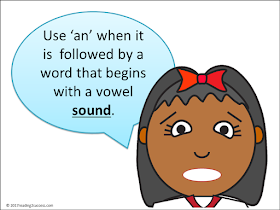Knowing when to use articles a or an. A is used when it is followed by a word that begins with a consonant sound. An is used when it is followed by a word that begins with a vowel sound. Since articles depend on the beginning sound of the following word, we began with the article - an and brainstormed words that begin with vowels: a, e, i, o and u. We wrote the article (an), drew an illustration representing each noun and the word. Next, we brainstormed nouns that begin with consonants:cat, tree, puppy, clock, rose and whale to use with the article a. For the project we used 12 by 9 white pieces of construction paper.
Making a big book to demonstrate when to use these articles is an effective way to teach children how to apply the rules.
Inside - articles and nouns Front with definitions
Making a big book to demonstrate when to use these articles is an effective way to teach children how to apply the rules.
Children determine where to place the pictures. In this activity the a or the an is placed before a picture (noun).
In the activity below, children had to decide if a or an came before the adjectives: full, happy, light, right, sour, sweet, awesome, enormous, empty, outside, open or ugly. The same rules apply as with the nouns.
Some confusion occurs when a word starts with a vowel but begins with a consonant sound: one. Other examples include a word that starts with a consonant but begins with a vowel sound: hour. Also, a is used when it is followed by a word that begins with y acting as a consonant.
Practice Paper to Demonstrate Learning
Some confusion occurs when a word starts with a vowel but begins with a consonant sound: one. Other examples include a word that starts with a consonant but begins with a vowel sound: hour. Also, a is used when it is followed by a word that begins with y acting as a consonant.
Practice Paper to Demonstrate Learning
Page with answers
Practice Page with Adjectives
Answers
Below are the templates that were used to make the book. Front Cover
Answers
Below are the templates that were used to make the book. Front Cover
Inside Page
Inside Page
Back Page
Back Page
Back Page
Some Confusion Occurs When:
Watch the Video



















































